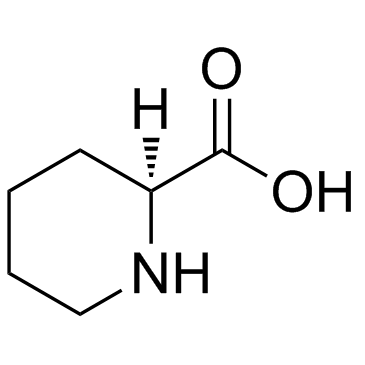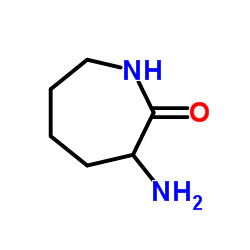D-Lysine

D-Lysine structure
|
Common Name | D-Lysine | ||
|---|---|---|---|---|
| CAS Number | 923-27-3 | Molecular Weight | 146.188 | |
| Density | 1.1±0.1 g/cm3 | Boiling Point | 311.5±32.0 °C at 760 mmHg | |
| Molecular Formula | C6H14N2O2 | Melting Point | 218ºC (dec.) | |
| MSDS | Chinese USA | Flash Point | 142.2±25.1 °C | |
Use of D-LysineD-Lysine is a useful raw material employed as an analog of lutenizing-hormone-releasing hormone and as a drug carrier in the form of polylysine. D-Lysine decreases renal uptake of radioactivity during scintigraphy and PRRT with low toxicity. D-Lysine not interferes with the natural amino acid metabolic balance[1][2]. |
| Name | D-lysine |
|---|---|
| Synonym | More Synonyms |
| Description | D-Lysine is a useful raw material employed as an analog of lutenizing-hormone-releasing hormone and as a drug carrier in the form of polylysine. D-Lysine decreases renal uptake of radioactivity during scintigraphy and PRRT with low toxicity. D-Lysine not interferes with the natural amino acid metabolic balance[1][2]. |
|---|---|
| Related Catalog | |
| Target |
Human Endogenous Metabolite |
| In Vivo | D-Lysine (400 mg/kg; i.v. or p.o.) dose not result in significantly greater inhibition of kidney uptake of '"In-DTPAOC, and Oral administration of D-lysine also reduces kidney uptake in rats[1]. |
| References |
| Density | 1.1±0.1 g/cm3 |
|---|---|
| Boiling Point | 311.5±32.0 °C at 760 mmHg |
| Melting Point | 218ºC (dec.) |
| Molecular Formula | C6H14N2O2 |
| Molecular Weight | 146.188 |
| Flash Point | 142.2±25.1 °C |
| Exact Mass | 146.105530 |
| PSA | 89.34000 |
| LogP | -1.04 |
| Vapour Pressure | 0.0±1.4 mmHg at 25°C |
| Index of Refraction | 1.503 |
| Storage condition | −20°C |
| Personal Protective Equipment | Eyeshields;Gloves;type N95 (US);type P1 (EN143) respirator filter |
|---|---|
| RIDADR | NONH for all modes of transport |
| WGK Germany | 3 |
| HS Code | 2922499990 |
| HS Code | 2922499990 |
|---|---|
| Summary | HS:2922499990 other amino-acids, other than those containing more than one kind of oxygen function, and their esters; salts thereof VAT:17.0% Tax rebate rate:9.0% Supervision conditions:AB(certificate of inspection for goods inward,certificate of inspection for goods outward) MFN tariff:6.5% General tariff:30.0% |
|
Cell-penetrating antimicrobial peptides - prospectives for targeting intracellular infections.
Pharm. Res. 32(5) , 1546-56, (2015) To investigate the suitability of three antimicrobial peptides (AMPs) as cell-penetrating antimicrobial peptides.Cellular uptake of three AMPs (PK-12-KKP, SA-3 and TPk) and a cell-penetrating peptide ... |
|
|
Pharmacological Suppression of CNS Scarring by Deferoxamine Reduces Lesion Volume and Increases Regeneration in an In Vitro Model for Astroglial-Fibrotic Scarring and in Rat Spinal Cord Injury In Vivo.
PLoS ONE 10 , e0134371, (2015) Lesion-induced scarring is a major impediment for regeneration of injured axons in the central nervous system (CNS). The collagen-rich glial-fibrous scar contains numerous axon growth inhibitory facto... |
|
|
Myristicin from nutmeg induces apoptosis via the mitochondrial pathway and down regulates genes of the DNA damage response pathways in human leukaemia K562 cells.
Chem. Biol. Interact. 218 , 1-9, (2014) Myristicin, an allylbenzene, is a major active component of various spices, such as nutmeg and cinnamon, plants from the Umbelliferae family or in some essential oils, such as oils of clove or marjora... |
| (R)-2,6-Diaminocaproic acid |
| (R)-lysine |
| EINECS 213-091-9 |
| Benzonitrile,2,6-diamino |
| D-Lysine |
| Lysine |
| D-2,6-Diaminohexanoic acid |
| (2R)-2,6-diaminohexanoic acid |
| (R)-2,6-Diaminohexanoic acid |
| r-lysine |
| MFCD00008234 |
 CAS#:3105-95-1
CAS#:3105-95-1 CAS#:462-94-2
CAS#:462-94-2 CAS#:2756-89-0
CAS#:2756-89-0 CAS#:28957-33-7
CAS#:28957-33-7 CAS#:70-54-2
CAS#:70-54-2
